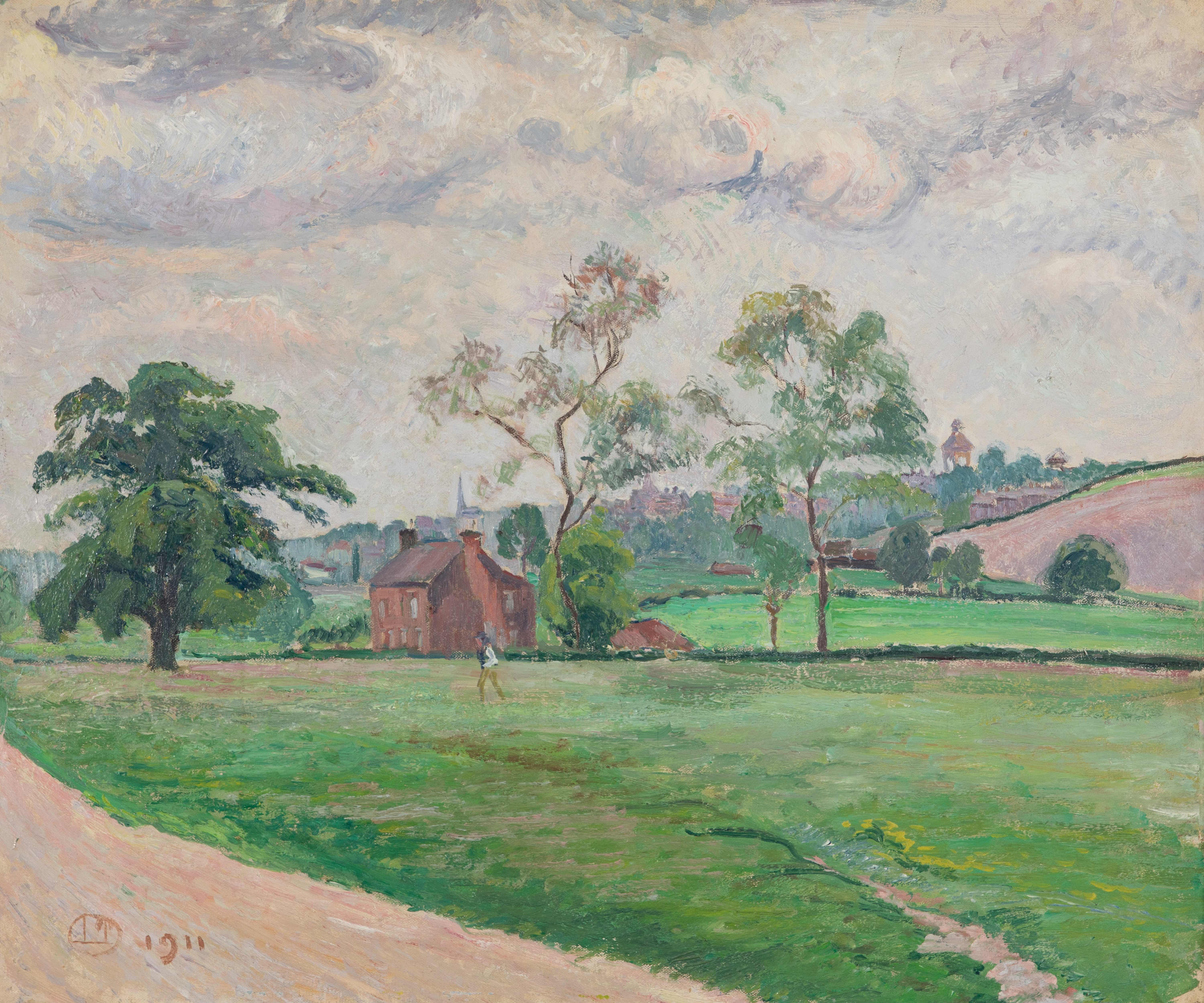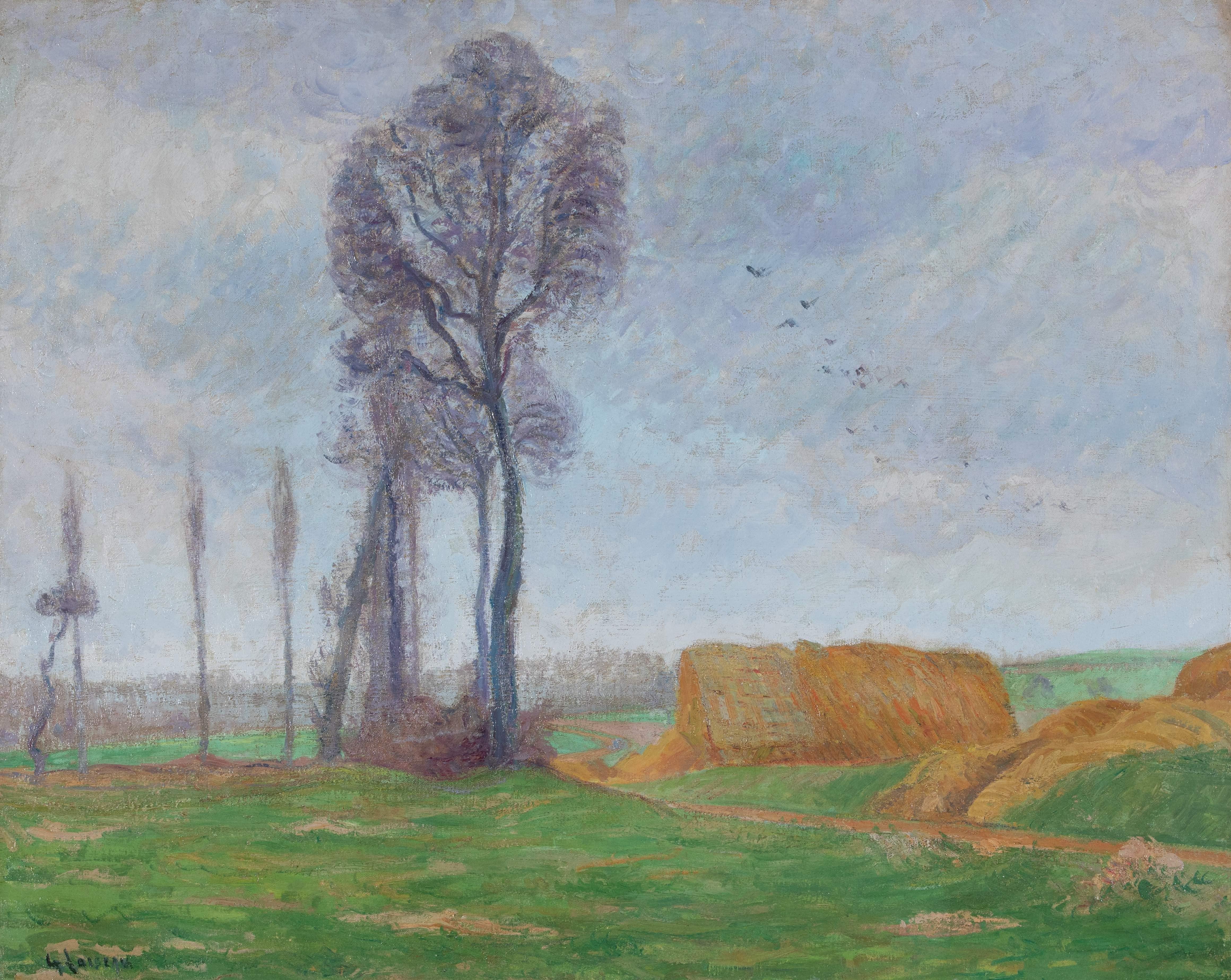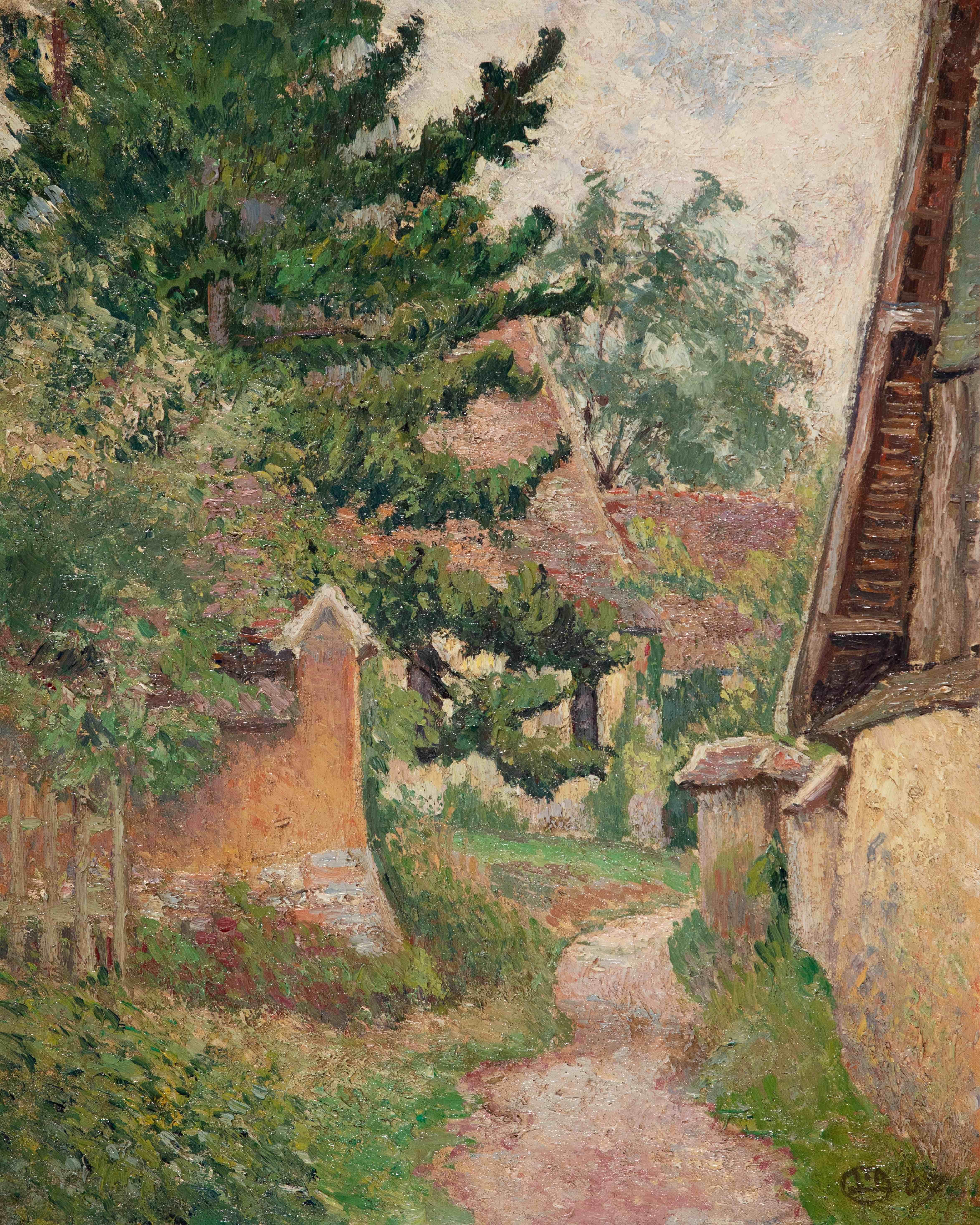Items Similar to Paysage du Viviers, French Post-Impressionist Oil Painting
Want more images or videos?
Request additional images or videos from the seller
1 of 10
Robert DebornePaysage du Viviers, French Post-Impressionist Oil Painting
About the Item
Robert Deborne
French 1870 - 1944
Viviers
Oil on canvas, signed lower right
Image size: 25 3/4 x 20 1/2 inches
Gilt frame
Robert Deborne (1870-1944) a French painter and Post-Impressionist has somehow escaped the recognition and acclaim afforded to his contemporaries who were also painting in the south of France in the early 20th century. He died in 1944, at which time his paintings were put away in his studio attic for more than half a century. However, on being brought to light again we can now see his lively depiction/interpretation of the area surrounding him over a hundred years ago.
Despite his prolificacy, the traces he leaves are tiny, and considering the little that we know of his career, one would be tempted to believe that the person concerned had something to do with it. Having organised no personal exhibition during his lifetime, maintaining no contact with any art dealer, not opening his studio to anyone, writing nothing, Robert Deborne closed rather brutally on the enigma of his person, notoriety portal, although he exhibited often at the Salon d’Automne in Paris (becoming a member in 1923) and the Salon du Sud-Est.
A noted talent in his day, Deborne exhibited with major artists at the Salon du Sud-Est. This salon exhibition was on during the winter, which was perfect for Deborne as he was able to paint all summer, his preferred season. The Salon was a forum for unknown, innovative, emerging artists. His paintings were hung alongside works by Paul Cézanne, Henri Matisse, Paul Gaugin, Georges Rouault, André Derain, Albert Marquet, Felix Vallotton and Edouard Vullard, to name but a few.
Deborne was exhibiting at the Salon du Sud-Est in 1905, the year when the press coined the then rather disparaging term of ‘Fauves’ (French for ‘wild beasts’) to describe artists using strong, separate, unnatural colours in a representational manner, moving away from the realism of impressionism. The phrase stuck and the new movement of Fauvism was recognised, of which Deborne was certainly a part and influenced by
- Creator:Robert Deborne (1870 - 1944, French)
- Dimensions:Height: 25.75 in (65.41 cm)Width: 20.5 in (52.07 cm)
- Medium:
- Movement & Style:
- Period:
- Condition:
- Gallery Location:London, GB
- Reference Number:1stDibs: LU52411800952
About the Seller
5.0
Gold Seller
These expertly vetted sellers are highly rated and consistently exceed customer expectations.
Established in 2007
1stDibs seller since 2014
66 sales on 1stDibs
Typical response time: 4 hours
- ShippingRetrieving quote...Ships From: London, United Kingdom
- Return PolicyA return for this item may be initiated within 14 days of delivery.
More From This SellerView All
- Les Cypres, French Post-Impressionist Landscape Painting, SignedLocated in London, GBOil on canvas, signed bottom right Image size: 29 x 40 inches (74 x 101 cm) Contemporary style handmade frame Provenance Artist's Estate Robert Deborne Robert Deborne was born in...Category
Early 20th Century Post-Impressionist Landscape Paintings
MaterialsCanvas, Oil
- Paysage du Vivarais avec une Ferme, French Post-Impressionist, Signed PaintingLocated in London, GBOil on canvas, signed bottom right Image size: 26 1/4 x 19 3/4 inches (41.5 x 50 cm) Hand made gilt frame Provenance Artist's Estate This work is sold with a certificate of authe...Category
Early 20th Century Post-Impressionist Landscape Paintings
MaterialsOil, Canvas
- Arbre en Fleurs, Oil Landscape, French Post-ImpressionistLocated in London, GBOil on board, mounted on panel, signed lower right Image size: 19 x 23 (48 x 58 cm) Contemporary style handmade frame £10,000 Provenance Artists Estate The Artist Robert Deborne...Category
Early 20th Century Post-Impressionist Landscape Paintings
MaterialsOil, Board
- The Heat of SummerLocated in London, GBOil on board, signed on verso Image size: 31 1/2 x 25 inches (80 x 64 cm) Framed This is a wonderful work of Pointillism, a technique of painting where small, distinct dots of colour are applied in patterns to form an image. This techniques relies on the ability of the eye and mind of the viewer to blend the colour spots into a fuller range of tones. The practice of Pointillism lies in sharp contrast to the traditional methods of blending pigments on a palette. Georges Seurat and Paul Signac developed the technique in 1886, branching from Impressionism. The term 'Pointillism' was coined by art critics in the late 1880s to ridicule the works of these artists, but is now used without its earlier pejorative connotations. The Artist Kenneth Walch Born Wimbledon 1927. After school he moved to Australia in the early 1950’s and won a place at the National Gallery Art School in Melbourne where he studied under Murray Griffin until 1953 when he returned to England. He then enrolled at St Martins School of Art where his principal tutor was the Colourist, Fredrick Gore. Gore introduced him to English post...Category
Mid-20th Century Pointillist Landscape Paintings
MaterialsOil, Board
- Duck Shooting, 19th Century Oil on Canvas LandscapeBy Eugene BatailleLocated in London, GBE. Bataille 1817 - 1882 Duck Hunting Oil on canvas Image size: 9½ x 12 inches, signed bottom right and verso Original frameCategory
19th Century Impressionist Landscape Paintings
MaterialsOil, Canvas
- Dorset Landscape, Contemporary Welsh Artist, Oil LandscapeBy Jeremy AndrewsLocated in London, GBJeremy Andrews Born 1974 Dorset Landscape Oil on canvas, signed Image size: 20 x 20 inches Framed Jeremy Andrews works in oils and uses traditional techniques such as under pai...Category
21st Century and Contemporary Contemporary Landscape Paintings
MaterialsCanvas, Oil
You May Also Like
- Stormy Weather, Colchester by Lucien Pissarro - Landscape paintingBy Lucien PissarroLocated in London, GBStormy Weather, Colchester by Lucien Pissarro (1863-1944) Oil on canvas 54.3 x 65.3 cm (21 ³/₈ x 25 ³/₄ inches) Signed with monogram and dated lower left, 1911 Provenance: The Brook...Category
1910s Post-Impressionist Landscape Paintings
MaterialsCanvas, Oil
- Péniches sur le Loing by Georges Manzana Pissarro - Landscape paintingBy Georges Henri Manzana PissarroLocated in London, GBPéniches sur le Loing by Georges Manzana Pissarro (1871-1961) Oil on canvas 54 x 65 cm (21 ¼ x 25 ½ inches) Signed and dated lower left, G. Manzana 1902 This work is accompanied by ...Category
Early 1900s Post-Impressionist Landscape Paintings
MaterialsCanvas, Oil
- Paysage d'Automne à Nesle la Vallée by Gustave Loiseau - Landscape paintingBy Gustave LoiseauLocated in London, GB*PLEASE NOTE UK BUYERS WILL ONLY PAY 5% VAT ON THIS PURCHASE. Paysage d'Automne à Nesle la Vallée by Gustave Loiseau (1865-1935) Oil on canvas 65 X 81.2 cm (25 ⁵/₈ x 32 inches) Sign...Category
1890s Post-Impressionist Landscape Paintings
MaterialsCanvas, Oil
- Les toits de Paris, coucher de soleil by Gustave Cariot - Parisian viewsBy Gustave Camille Gaston CariotLocated in London, GB*PLEASE NOTE UK BUYERS WILL ONLY PAY 5% VAT ON THIS PURCHASE. Les toits de Paris, coucher de soleil by Gustave Cariot (1872-1950) Oil on canvas 47 ...Category
1890s Pointillist Landscape Paintings
MaterialsCanvas, Oil
- La Sente de l'Eglise, Bazincourt by Lucien Pissarro - Landscape paintingBy Lucien PissarroLocated in London, GB*PLEASE NOTE UK BUYERS WILL ONLY PAY 5% VAT ON THIS PURCHASE. La Sente de l'Eglise, Bazincourt by Lucien Pissarro (1863-1944) Oil on canvas 41.2 x 33 cm (16 ¹/₄ x 13 inches) Monogra...Category
Early 1900s Post-Impressionist Landscape Paintings
MaterialsCanvas, Oil
- Champs Elysses at Dusk, Oil Painting by Jacques GastonBy Jacques GastonLocated in Long Island City, NYArtist: Jacques Gaston, French XXth Title: Champs Elysses at Dusk Year: circa 1950 Medium: Oil on Canvas mounted to Wood, signed l.r. Image: 24 x 36 in. (60.96 x 91.44 cm) Frame: 33 ...Category
1950s Fauvist Landscape Paintings
MaterialsCanvas, Wood, Oil
Recently Viewed
View AllMore Ways To Browse
Post Light
Post Antique
Henri Robert
French Impressionism Oil Paintings
19th Impressionist Paintings
19th Century Impressionist Paintings
Antique Sign Posts
George Post Paintings
19th Century Impressionist Oil Paintings
Unknown Artist Impressionist Painting
Robert Day Paintings
France Oil Painting 3 X 3
Cezanne Oil
Antique Post Impressionist Oil Painting
19th Century Impressionist Oil In Canvas
Post Impressionism Oil Paintings
Early 20th Century Post Impressionist Painting
Fauvism Painting




